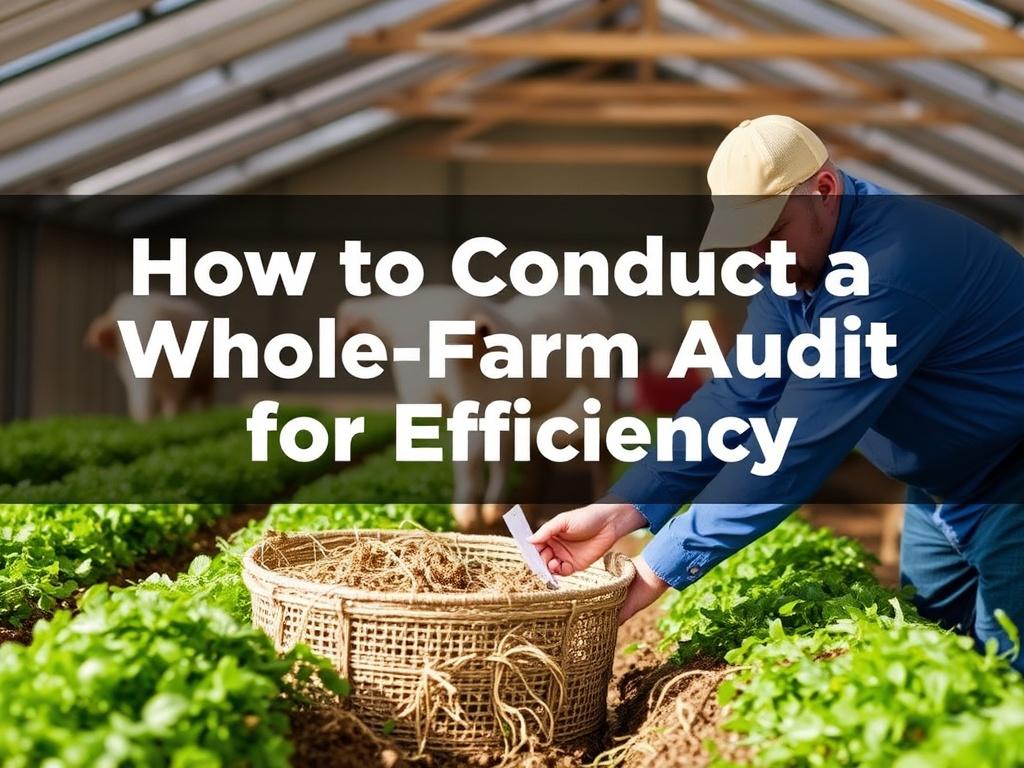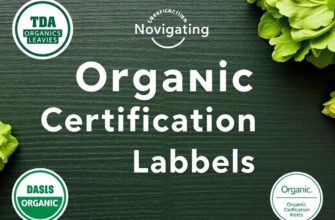Международное название:
Синонимы:
Характеристики:
| Сложность: | |
| Цикл развития: | |
| Световой режим: | |
| Режим полива: | |
| Температура: | |
| Почва: | |
| Ключевая черта: |
Цвет листвы
Цвет бутонов
Размеры цветка
Систематика:
| Домен: | |
| Царство: | |
| Отдел: | |
| Класс: | |
| Порядок: | |
| Семейство: | |
| Род: |
Running a farm is part art, part science, and a constant negotiation between what you can control and what the weather, markets, or equipment decide. If you’ve ever felt that there’s more you could be doing to reduce costs, boost yields, or simply make your days less chaotic, a whole-farm audit is the tool you need. This article walks you through that process in plain language, with practical steps, checklists, and examples so you can examine every corner of your operation and find real opportunities for efficiency. Whether you manage a small family farm or a mid-sized enterprise, the ideas here will help you make smarter decisions, justify investments, and build a continuous improvement routine that fits your farm’s rhythm.
- What Is a Whole-Farm Audit and Why It Matters
- Preparing for the Audit: Scope, Team, and Timing
- Define the scope
- Assemble the team
- Choose timing wisely
- Step 1: Gather Records and Baseline Information
- Financial records
- Production records
- Resource use records
- Maintenance and equipment records
- Regulatory and compliance documents
- Step 2: Walk the Farm — Physical Inspection
- Fields and soils
- Irrigation and water systems
- Buildings and infrastructure
- Machinery and equipment
- Labor workflow and practices
- Step 3: Quantify Inputs and Outputs
- Key performance indicators to track
- Use simple calculations
- Step 4: Analyze Financial Efficiency
- Profit centers and loss centers
- Cost drivers
- Seasonal cash flow
- Step 5: Evaluate Machinery, Fuel Use, and Maintenance
- Match equipment to the job
- Fuel efficiency checks
- Maintenance schedule and costs
- Step 6: Review Labor and Workflow Efficiency
- Time-motion assessment
- Skill mix and training
- Outsourcing and mechanization
- Step 7: Assess Crop and Livestock Performance
- Crop audits
- Livestock audits
- Grazing and pasture management
- Step 8: Check Environmental and Regulatory Compliance
- Soil and nutrient management
- Water and waste management
- Animal welfare and biosecurity
- Step 9: Technology, Data, and Record-Keeping
- What data do you collect?
- Software and hardware
- Data ownership and accessibility
- Step 10: Benchmarking and External Comparison
- Use peer groups and industry data
- Set realistic targets
- Step 11: Prioritize Findings — Quick Wins to Long-Term Investments
- Prioritization framework
- Develop an action matrix
- Sample Audit Action Matrix
- Step 12: Implement Changes and Track Progress
- Assign ownership and deadlines
- Measure and report
- Adjust and learn
- Step 13: Institutionalize Continuous Improvement
- Regular mini-audits
- Annual full audit
- Build a culture of efficiency
- Tools, Templates, and Resources
- Simple audit toolkit
- Where to find help
- Common Pitfalls and How to Avoid Them
- Data gaps and messy records
- Too many priorities
- Ignoring human factors
- Overreliance on technology
- Example Scenario: A Small Mixed Farm Audit
- What the audit found
- Actions taken
- Results after one season
- Checklist: Quick Audit Steps You Can Do This Week
- Frequently Asked Questions
- How long does a whole-farm audit take?
- Do I need an external auditor?
- How often should I audit my farm?
- What’s the single best place to start?
- Practical Tips for Keeping the Audit Process Friendly and Useful
What Is a Whole-Farm Audit and Why It Matters
A whole-farm audit is a structured review of all the inputs, outputs, processes, and resources on your farm. It’s broader than a simple equipment inspection or a financial review; it ties physical operations to economic outcomes and environmental impacts. The goal is not to point fingers but to see where small changes can yield big benefits—less wasted time, lower input costs, healthier soils, and stronger cash flow.
Think of a farm audit as a health check for your operation. Just like a doctor looks at symptoms, labs, and history, your audit looks at production data, financial records, energy and water use, machinery condition, labor allocation, and compliance with laws. You’ll come away with a prioritized list of actions: quick wins, medium-term investments, and long-term strategy shifts.
Preparing for the Audit: Scope, Team, and Timing
Before you dive in, take a moment to set the stage. A successful audit needs clear boundaries, the right people at the table, and a practical timeline.
Define the scope
Start by deciding the physical and operational boundaries. Will you audit everything—cropping, livestock, machinery, buildings, irrigation, and business finances—or focus on a subset first? A full audit is ideal, but many farms start with a phased plan: financials and machinery first, then soil and water, then labor and processes.
Assemble the team
You don’t have to do this alone. Include people with different perspectives: the farm manager, a trusted worker who knows day-to-day routines, your accountant or bookkeeper, and maybe an outside consultant or extension agent who can bring fresh ideas. If you use specialists—agronomists, veterinarians, energy auditors—schedule them as part of the audit.
Choose timing wisely
Timing matters. Avoid peak busy seasons like planting or harvest unless you only do a desk-based audit. The best windows are slower times when you can inspect equipment, review records, and talk to staff without urgent field work interrupting. Still, you’ll need to collect production-season data, so plan follow-ups after busy periods.
Step 1: Gather Records and Baseline Information
A meaningful audit starts with data. Before you walk the fields or poke around in the machinery shed, collect the records that tell your farm’s story.
Financial records
Pull together your income statements, balance sheets, tax returns, and cash flow statements for the past 2–3 years. If you don’t keep formal accounts, assemble sales receipts, invoices for seed/fertilizer/feed, fuel invoices, utility bills, and payroll records. You’ll want to see trends, not just snapshots.
Production records
Collect yield maps, harvest records, stocking rates, feed conversion ratios, breeding and calving dates, pesticide and fertilizer application logs, and seed lot information. Digital files are great, but even handwritten field books are useful if they’re consistent.
Resource use records
Get electricity and fuel bills, water use reports (if metered), irrigation schedules, and chemical purchase records. These numbers will help you calculate input efficiency (for example, liters of water per kilogram of crop).
Maintenance and equipment records
Review service logs, repair receipts, and machinery purchase dates. Knowing the operational hours of tractors and combines, and the age and condition of key equipment, helps prioritize replacements or tune-ups.
Regulatory and compliance documents
Keep any environmental permits, nutrient management plans, animal health records, and worker safety documentation accessible. Noncompliance can be a hidden cost, so include it in your audit radar.
Step 2: Walk the Farm — Physical Inspection
There’s no substitute for walking each field, paddock, barn, and piece of equipment. In-person observations reveal inefficiencies that numbers alone can’t show.
Fields and soils
Look for soil erosion, compaction, variable crop growth that could indicate fertility or drainage issues, and ranges of weed pressure. Note where yields are consistently low and ask whether it’s a soil problem, a management issue, or something else.
Irrigation and water systems
Check for leaks, inefficient sprinkler layouts, and mismatched delivery rates. Are valves easy to access? Do pump motors run constantly instead of on demand? Poor irrigation efficiency wastes water and energy.
Buildings and infrastructure
Inspect feed stores, silage pits, barns, and storage sheds. Poor ventilation, broken gates, or inadequate storage can lead to feed spoilage, animal stress, and extra labor.
Machinery and equipment
Evaluate tractors, combines, planters, spreaders, and pumps for wear, fuel leaks, or poor calibration. Note whether implements are properly matched to the tractor horsepower—mismatches reduce fuel efficiency and increase soil compaction.
Labor workflow and practices
Watch how tasks are performed. Are workers walking long distances between tasks due to poor layout? Are there repetitive, unnecessary steps in routine chores? Often, small layout changes can save hours each week.
Step 3: Quantify Inputs and Outputs
Turning observations into metrics is where the audit becomes actionable. Use the records and your inspections to quantify key performance indicators (KPIs).
Key performance indicators to track
- Yield per hectare or per animal
- Input cost per unit produced (seed, fertilizer, feed, chemicals)
- Fuel and energy consumption per hectare or per animal unit
- Water usage per kilogram of crop or per animal
- Labor hours per activity or per unit of production
- Machine downtime and maintenance cost per hour
- Waste and spoilage rates (feed, grain, milk)
Use simple calculations
If you don’t have fancy software, spreadsheet these numbers. For example, calculate fertilizer cost per tonne of output, or liters of diesel per hectare. Even simple ratios reveal where costs are hanging on.
Step 4: Analyze Financial Efficiency
Financial analysis connects operations to profitability. Use your KPIs to see which parts of the farm are pulling you toward or away from your financial goals.
Profit centers and loss centers
Break down income and expenses by enterprise—crop types, livestock classes, custom work. Some enterprises may be cross-subsidized by others without you realizing it. The audit clarifies which activities contribute the most to the bottom line and which need rethinking.
Cost drivers
Identify the top three input costs that cut into profit—fertilizer, feed, fuel, or labor. Then focus on those as targets for efficiency improvements. For example, if feed is your biggest expense, improving feed conversion or reducing wastage could be high-impact.
Seasonal cash flow
Map your cash flow across the year. Many farms are profitable on paper but face seasonal cash shortages. If inputs come due before sales, consider short-term financing options, staggered input purchases, or changing crop mixes to smooth cash flow.
Step 5: Evaluate Machinery, Fuel Use, and Maintenance
Machinery often represents a large share of capital and operating costs. A focused audit on equipment can uncover substantial savings.
Match equipment to the job
Using the right implement with the right tractor size preserves fuel and reduces wear. Over-capacity machines may sit idle yet cost in depreciation; under-capacity machines get overworked and consume more fuel.
Fuel efficiency checks
Track fuel use per task or per field. Modern tractors often provide telematics or fuel consumption data; if unavailable, record liters used and acres covered for representative jobs to estimate fuel per hectare.
Maintenance schedule and costs
Preventive maintenance can be cheaper than reactive repairs. Create or refine a maintenance calendar keyed to hours of operation and seasonal needs. Keep spare parts for critical failures and identify machines that require frequent repairs—these might be replaced sooner.
Step 6: Review Labor and Workflow Efficiency

Labor is one of the most human parts of farming and also one of the hardest to optimize. The audit should examine who does what, how long tasks take, and whether workflows are sensible.
Time-motion assessment
Select common tasks—milking, feeding, irrigating, record entry—and time them. Look for bottlenecks: long walks, waiting for equipment, or duplicated paperwork. Often the fix is a layout change, different tools, or clearer task assignments.
Skill mix and training
Ensure workers’ skills match their tasks. Investing in training can boost productivity and safety. Cross-train staff so one absence doesn’t cripple operations.
Outsourcing and mechanization
Some tasks may be cheaper to outsource (custom harvesting, specialized repairs) than to do in-house. Consider if partial mechanization (automated feeders, GPS-guided tractors) reduces labor costs enough to justify the investment.
Step 7: Assess Crop and Livestock Performance
Dive deep into biological productivity—because farming’s ultimate aim is to convert inputs into healthy yields or animals efficiently.
Crop audits
Compare expected yields with actual results. Use soil tests, pest/disease records, and application timetables to diagnose gaps. Consider precision practices—variable rate applications, split fertilization, or cover crops—to close yield or quality gaps.
Livestock audits
Look at health metrics (mortality, morbidity), reproductive performance, feed conversion ratios, and average daily gain. Veterinary records and feed analyses reveal whether nutrition or housing changes could raise performance.
Grazing and pasture management
Assess pasture utilization and rest periods. Overgrazing reduces long-term productivity. Rotational grazing, reseeding, or targeted fertilization can boost forage quality and reduce feed costs.
Step 8: Check Environmental and Regulatory Compliance
An audit must include environmental stewardship and regulatory obligations. Ignoring these risks fines, remediation costs, and reputation damage.
Soil and nutrient management
Ensure nutrient applications match crop needs and that manure management aligns with local regulations. A nutrient budget can reduce over-application and runoff.
Water and waste management
Inspect runoff channels, buffer strips, and storage for wash water and effluent. Leaks from storage or poorly sited runoff areas can create environmental hazards and legal headaches.
Animal welfare and biosecurity
Review housing, handling systems, and disease prevention protocols. Good welfare often correlates with productivity, and preventative biosecurity wards off expensive outbreaks.
Step 9: Technology, Data, and Record-Keeping
Modern farms use data to make better decisions, but only if that data is accurate and accessible. Your audit should evaluate how you collect, store, and use information.
What data do you collect?
List all records: paper field books, spreadsheets, software dashboards, and service invoices. Identify gaps like missing yield maps, untracked fuel, or no veterinary treatment logs.
Software and hardware
Consider farm management software, telematics, or IoT sensors where useful. But don’t buy tech for tech’s sake—ensure it answers a question you need to solve and that someone will use it regularly.
Data ownership and accessibility
Set rules for who updates records and how often. Make records accessible to those who need them. Regularly back up digital files and keep a physical binder of critical documents as a backup.
Step 10: Benchmarking and External Comparison
Knowing how you compare to peers helps set realistic goals. Benchmarks can be regional averages, industry standards, or data from extension services.
Use peer groups and industry data
Compare yields, input costs, and labor usage to similar farms. Extension services, industry groups, and cooperatives often publish benchmarks. If you’re significantly off the norm, dig into why.
Set realistic targets
Based on benchmarking, set short- and medium-term targets. For example, reduce fertilizer cost per hectare by 10% within two seasons, or lower diesel use by 8% per hectare with service and route improvements.
Step 11: Prioritize Findings — Quick Wins to Long-Term Investments
You’ll likely uncover many opportunities, but you can’t do everything at once. Prioritize actions by impact, cost, and feasibility.
Prioritization framework
- Quick wins: Low cost, high impact, short implementation time (e.g., fixing leaks, adjusting fertilizer rates, correcting tire pressures).
- Medium projects: Moderate cost or longer timelines (e.g., new irrigation scheduling system, retraining staff).
- Major investments: High cost or long lead time but high long-term return (e.g., replacing a combine, installing solar panels, converting to no-till).
Develop an action matrix
Create a simple table that lists each issue, estimated cost, expected savings or benefit, timeline, and responsible person. This turns audit findings into a roadmap rather than a list of good intentions.
Sample Audit Action Matrix
| Issue | Estimated Cost | Expected Annual Savings/Benefit | Timeline | Responsible |
|---|---|---|---|---|
| Irrigation leaks on Block B | $1,200 | Saved water/fuel = $1,000/year | 2 weeks | Farmhand & Irrigation Tech |
| Over-application of nitrogen on Field 3 | $400 (soil testing + calibration) | $800/year + reduced runoff | 1 month | Manager & Agronomist |
| Old tractor with frequent repairs | $35,000 (replacement) | Reduced repair cost and fuel = $6,000/year | 1 season | Owner |
Step 12: Implement Changes and Track Progress
Now comes the most important part: action. Implementation requires discipline, communication, and a way to measure success.
Assign ownership and deadlines
For each action, assign a single responsible person and set realistic deadlines. Weekly or monthly check-ins maintain momentum and allow you to address obstacles early.
Measure and report
Create a simple dashboard of the top 6 KPIs you want to improve. Update them regularly and review in team meetings. Celebrate wins—small improvements compound over time.
Adjust and learn
Not every change will work as planned. Use trial periods and measure outcomes. If an approach doesn’t deliver, learn why and try a different tactic. The audit should be a living process, not a one-time exercise.
Step 13: Institutionalize Continuous Improvement
The best farms build audit thinking into routine management. Make periodic mini-audits and annual full audits part of your farm calendar.
Regular mini-audits
Schedule quarterly checks of key systems: equipment, irrigation, and finances. These small reviews catch slippages before they become big problems.
Annual full audit
A yearly comprehensive review ties short-term changes to long-term strategy. Use the same format so you can compare year-on-year results and refine goals.
Build a culture of efficiency
Involve staff in setting efficiency goals and soliciting ideas. Workers who contribute to improvements are more likely to adopt new practices and sustain gains.
Tools, Templates, and Resources
You don’t need expensive software to do a good audit. Start with these practical tools and templates, then scale up if needed.
Simple audit toolkit
- Spreadsheet templates for income/expense and KPI tracking
- Field and equipment checklists (paper or mobile)
- Soil test kits and guides for sampling
- Fuel and water logbooks
- Maintenance calendar (digital or printed)
- Contact list for specialists—agronomists, vets, accountants
Where to find help
Local extension services, agricultural universities, and cooperative extension agents often provide audit assistance, benchmarking data, and training. Industry groups and online forums can also offer practical tips and cost-savings ideas specific to your enterprise.
Common Pitfalls and How to Avoid Them
Experienced auditors and farmers know there are predictable traps that can derail a useful audit.
Data gaps and messy records
If your records are incomplete, start by improving record-keeping. Don’t try to guess important numbers—create a plan to collect them next season.
Too many priorities
An audit can generate a long list of potential actions. Prioritize ruthlessly. Implement a few high-impact changes rather than spreading resources too thin.
Ignoring human factors
Operational changes can fail if staff aren’t consulted or trained. Communicate clearly, involve workers in planning, and allocate time for new routines to settle.
Overreliance on technology
Technology can help, but only when it answers a clear need. Avoid buying gadgets before you know how you’ll use the data they produce.
Example Scenario: A Small Mixed Farm Audit
Imagine a 150-hectare mixed farm with 80 dairy cows, 50 hectares of cereals, and rotational pasture. The farmer suspects feed costs and fuel are high, milk yields vary, and irrigation bills are climbing.
What the audit found
- Feed wastage in the feed alley due to poor trough design—10% of purchased feed lost to spillage.
- Two irrigation leaks and poorly scheduled run times leading to 15% more water usage than similar farms locally.
- An old tractor that consumed 20% more fuel and had frequent downtime.
- Inconsistent milking routine producing variable yields and stress in cows.
Actions taken
- Replace feed troughs and redesign feeding lanes to reduce spillage.
- Fix leaks and install a simple moisture sensor system to optimize irrigation scheduling.
- Sell the old tractor and lease a more efficient model in the short term while saving for replacement.
- Standardize the milking routine, provide staff training, and install a basic hygiene checklist.
Results after one season
Within a year the farmer reported a 6% reduction in overall feed costs, a 10% drop in fuel and irrigation expenses, and more consistent milk yields that improved overall farm profitability. Key to success was prioritizing quick wins, tracking KPIs, and involving staff in problem-solving.
Checklist: Quick Audit Steps You Can Do This Week

- Gather last year’s income and expense records into one spreadsheet.
- Walk one field and note visible soil issues, compaction, or drainage problems.
- Check tire pressures on all tractors and implements and correct them.
- Inspect irrigation fittings for obvious leaks and fix simple ones yourself.
- Time a routine task (feeding, milking) to know how long it takes and where time is being lost.
- Make one small change and track its effect for a month (e.g., close a gate to reduce walking time).
Frequently Asked Questions
How long does a whole-farm audit take?
A full audit can take several weeks to a few months depending on farm size, data availability, and the level of detail. You can complete smaller audits in a day or a weekend to get immediate insights.
Do I need an external auditor?
External auditors bring objectivity and specialized knowledge, which is useful especially for financial or environmental compliance. However, you can perform many elements yourself with good record-keeping and a structured approach. Combining internal audits with periodic external reviews is often effective.
How often should I audit my farm?
Mini-audits quarterly and a full audit annually is a practical rhythm. The exact frequency depends on how rapidly your farm changes, your commodity cycles, and regulatory requirements.
What’s the single best place to start?
If you must pick one place, start with inputs that cost the most—feed for livestock, fertilizer for crops, and fuel for machinery. Small improvements in these areas often yield significant returns.
Practical Tips for Keeping the Audit Process Friendly and Useful

If audits sound intimidating, make them friendly and practical. Start small, involve the whole team, and focus on learning rather than fault-finding. Use plain language, keep records simple, and set realistic goals. Celebrate improvement to keep morale high—efficiency is both a numbers game and a people game.
Conclusion
Conducting a whole-farm audit is a powerful way to understand how resources flow through your operation and identify clear opportunities to save money, boost productivity, and reduce environmental risk. Start by gathering records and walking the farm, quantify key metrics, and analyze finances and machinery use. Prioritize actions into quick wins, medium projects, and major investments, assign ownership, and track progress with a simple dashboard. Make audit thinking part of your regular calendar—small, consistent improvements add up to big gains over time. With a structured approach, the whole-farm audit becomes not just an occasional task but a practical habit that keeps your farm resilient, efficient, and profitable.
Оценивайте статью, делитесь материалом с друзьями в социальных сетях, а также высказывайте свое мнение в обсуждении ниже! ![]()







